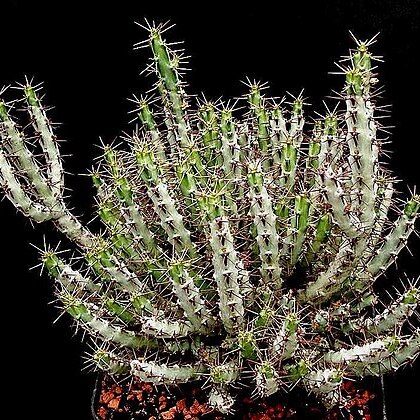Succulent spiny densely tufted shrublet to c. 20–40 cm high; rootstock tuberous fleshy, merging into a short stem below ground with numerous branches arising at or below ground level to form a compact clump to 2 m in diameter.
Spine shields to 12 × 2 mm, narrowly obovate, decurrent to ± halfway or almost touching the flowering eye below, brown becoming grey; spines stout, 8–17 mm long, widely diverging, prickles 0.5–2 mm long.
Branches to c. 50 cm long, sharply 4-angled, 1–2 cm in diameter, sparsely rebranching, with a darker stripe along the angles; angles with shallow tubercles c. 1.5–2 cm apart along the margins.
Cyathia c. 3 × 5 mm, with cup-shaped involucres; glands c. 1 × 2.75 mm, transversely oblong, bright yellow; lobes 1 × 1.5 mm, rounded, denticulate.
Female flower: styles 3 mm long, joined at the base, apices minutely bifid.
Cymes solitary, simple, subsessile; bracts c. 1.75 × 1.5 mm, oblong.
Male flowers: bracteoles 2.5 mm long, fimbriate; stamens 4 mm long.
Capsule 3 × 4 mm, obtusely lobed, sessile, purplish.
Seeds 2.3 × 1.7 mm, ovoid, verrucose.
Leaves 1 × 1 mm, deltoid, deciduous.

